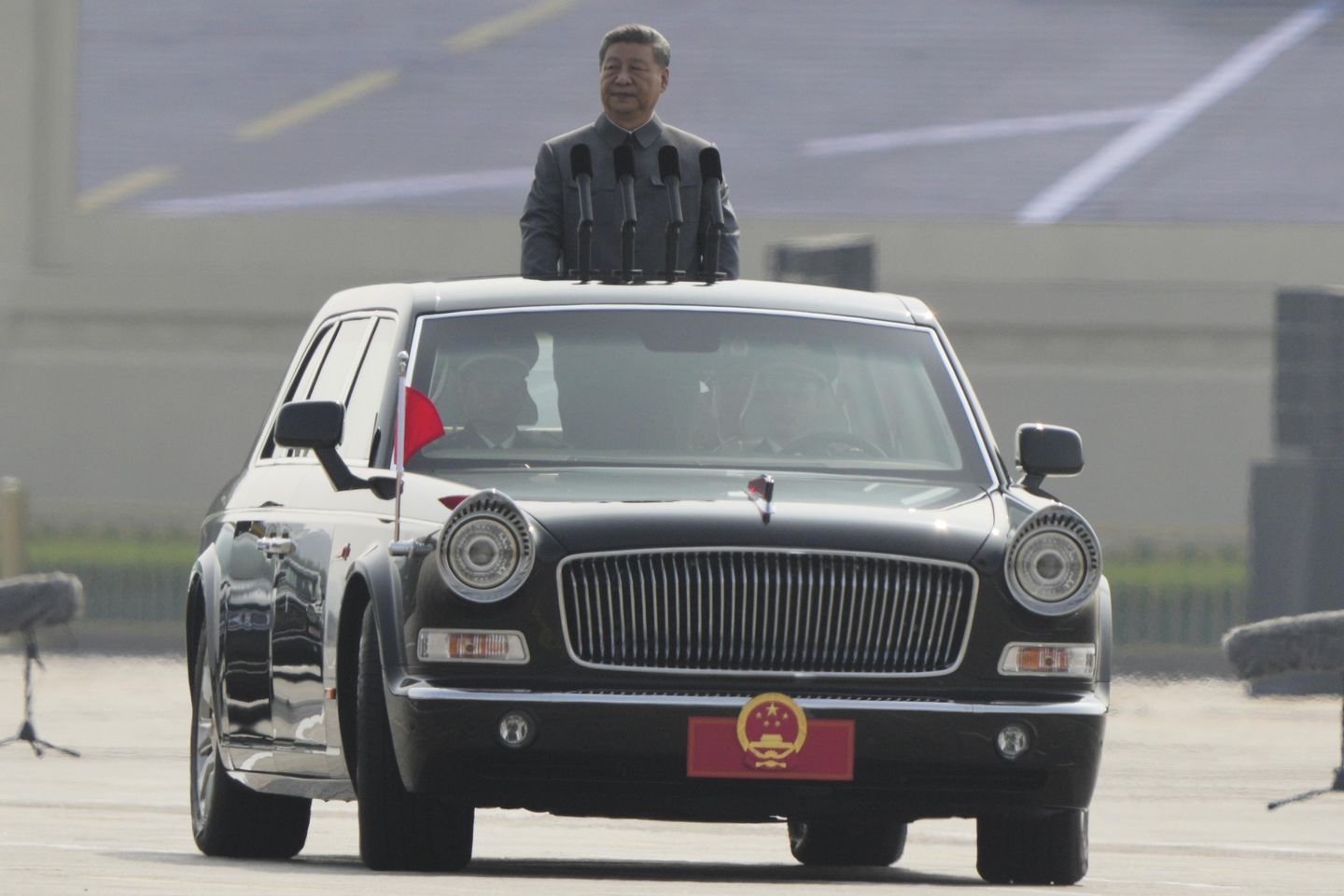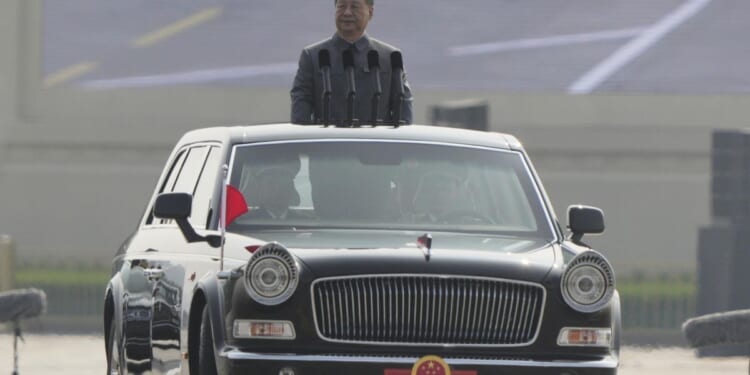
NEWS AND ANALYSIS:
The Chinese Communist Party and its armed wing, the People’s Liberation Army, last month began a major shift away from the 40-year-old strategy known as “hide and bide” — keeping a low profile while advancing military and economic power — according to an Air Force think tank report.
Instead, Chinese supreme leader Xi Jinping announced during a massive military parade showing off new weapons and firepower that the communist regime is now the leader of a forthcoming world order designed to replace the United States.
“The September 3rd Victory Day parade in Beijing showcased an array of military capabilities intended to demonstrate the fruits of its decades-long modernization effort,” the report by the China Aerospace Studies Institute said.
“China sought to promote itself as a world leader offering an alternative vision to the U.S.-led international system while the aerospace capabilities paraded down Changan Avenue and flying over Beijing were intended to deliver the message that the People’s Liberation Army (PLA) is a first rate aerospace power capable of defeating the U.S. military.”
The parade signaled the PLA’s emergence as a new global military force armed with weapons capable of attacking in all domains — sea, air, ground, space and cyber — using both manned and unmanned systems, the report said.
Mr. Xi also declared during remarks at the parade marking the anniversary of the end of World War II that a new order is needed to eliminate war at a time when “humanity is again faced with a choice of peace or war.”
Flanked on the dais by Russia’s Vladimir Putin and North Korea’s Kim Jong-un, the Chinese leader declared that the West is in decline and Asia, led by a communist China that will not be bullied by the United States, is rising.
Brandishing all elements of China’s nuclear triad of land- and sea-based missiles and strategic bombers, a major section of the parade showcased new unmanned weapons and counter-drone warfare systems.
“China’s Victory Day parade was an opportunity for China to present itself as an alternative to U.S. leadership of the international order and display its ruthless pursuit of its military modernization goals,” the report said.
China is also aggressively seeking to spread its model in the developing world and to win over U.S. allies and partners, the report said.
“Countering these efforts where possible is essential,” the report said. “While a military parade is neither a demonstration of operational effectiveness or the performance of military capabilities, if it is placed in the context of increased training tempo, better training, and improvement of military talent acquisition, it is clear that the PLA is well on its way to becoming a military that can fight informationized and eventually intelligentized wars.”
The nine-page report is headlined “Hiding and Biding No More: Military Parade Intended to Send Message that China is World Leader Capable of Deterring and Defeating the United States.”
“Hide and bide” was the CCP’s low-key military and economic strategy for decades after the disaster of the Cultural Revolution in China that ended in 1976.
It was based on an ideological retrenchment put in place by then-CCP leader Deng Xiaoping, who argued that China had to avoid drawing attention to its modernization. His successor, Jiang Zemin, then coined the policy as “hide your strength; bide your time” while gaining power.
The think tank report was written by Eli Turk and Kevin Pollpeter. Mr. Turk is a China specialist with the SOSi Center for Intelligence, Research, and Analysis. Mr. Pollpeter is a China expert with CNA Analysis and Solutions.
Frank Miller, a former DIA officer specializing in China, said the military parade was designed to promote the CCP narrative that China is ascending while the United States is in decline.
“They’re getting stronger and the old hide-and-bide from the Deng Xiaoping days, that’s gone,” Mr. Miller said. “And they’re kind of throwing it in our face as much as they can, when they can. And [the parade] was a good example.”
China toymaker fined for spying on kids
The Justice Department last week fined a Chinese toymaker charged with illegally obtaining data on American children from its robotic toys.
In a stipulated order together with the Federal Trade Commission, Justice said it resolved allegations of illegal privacy violations of American kids by China-based toymaker Apitor Technology Co. Ltd.
The toymaker was accused of violating the 1998 Children’s Online Privacy Protection Act through its programmable toy robots.
The law prohibits online services from collecting, using or disclosing personal information from children under age 13, unless parents give their consent.
“The Justice Department will vigorously work to ensure businesses respect parents’ rights to decide when their children’s personal information can be collected and used,” said Brett A. Shumate, assistant attorney general of the Civil Division. “We will continue to work with the FTC to stop unlawful intrusions on children’s privacy.”
A civil complaint filed last month in federal court in San Francisco stated that Apitor uses an app to operate toys that move, and through the Android app secretly collected geolocation data on children under age 13.
“Ultimately, defendant’s surreptitious collection of underage users’ geolocation information causes injury by compromising sensitive personal information of children,” the complaint said, noting the failure under law to obtain parental consent.
The court order requires Apitor to stop collecting data on children without first directly notifying parents and obtaining consent. It also imposed a $500,000 civil penalty, but the fine was suspended because the company said it could not pay, the Justice Department said in a statement.
The stipulation agreement says Apitor neither admits nor denies the allegations in the complaint. It directs the company to delete all personal information obtained from children.
Spokesmen for Apitor and the Justice Department did not immediately respond to a request for comment.
China, in the past several decades, has been collecting masses of data on Americans stolen from government and private sector networks. Analysts believe the data is part of the Chinese government’s efforts to develop artificial intelligence for spying or information warfare purposes.
Apitor is the international brand name of Shenzhen Zhihou Technology Co., Ltd., a Shenzhen-based company founded in 2019. The company sells educational robots, building-block kits and smart toys.
While Apitor markets itself internationally as an education company and toy manufacturer, its parent entity, Shenzhen Zhihou, has extensive links to security and ideological education projects in China, according to China specialist L.J. Eads.
The company works with Chinese security services through interactive training. “These include immersive public security, civil air defense, traffic safety, anti-drug, and ‘Future Police School’ security education centers, often inaugurated with the participation of local Public Security Bureaus and senior officials from the Zhejiang Provincial Public Security Department,” said L.J.. Eads, head of the research firm Data Abyss.
Many projects explicitly integrate “party-building culture” and ideological messaging alongside safety instruction, he said.
Mr. Eads said Apitor functions as an extension of CCP civic indoctrination efforts, especially targeting youth by embedding Party and police narratives in its educational products.
“Internationally, the Apitor brand may appear neutral, but its corporate parent’s domestic role in CCP-driven campaigns creates reputational risk if foreign partners, schools, or governments adopt Apitor products unaware of this dual alignment,” he said.
Australian broadcaster quotes intelligence report on militarized ferries
China’s military is building up a fleet of commercial ferries for use as military transports amid growing fears of a future invasion of Taiwan, according to a Defense Intelligence Agency report disclosed in Australia.
The Australian Broadcasting Corporation obtained the DIA report and disclosed Sept. 30 that the classified file was given to the five-nation Five Eyes intelligence alliance, of which Australia’s spy service is part.
Earlier this year, intelligence agencies tracked about 30 Chinese commercial ferries modified for military use that took part in military exercises.
A total of 70 ferries are under construction with militarized features, such as reinforced bow doors, the report said. The vessels are expected to be used to transport tanks, armored vehicles and troops and will be operational by 2026.
U.S. military commanders have said China’s military is preparing for action against Taiwan and was ordered to be ready for strikes by 2026.
Earlier this year, Chinese state media showed civilian ferries taking part in PLA amphibious landing drills.
During the exercise, a large amphibious barge system for moving troops and tanks onto shores was unveiled.
A report by the Indo-Pacific Command’s legal affairs office said PLA use of commercial ships undermines the law of armed conflict and can result in attacks on the ferries.
Direct insertion of troops into conflict is a belligerent act normally reserved for warships. Yet the PLA is intent on using commercial roll on/roll off, or RORO, ships for military transport, the report said.
“The PLA has integrated commercial ROROs into its amphibious invasion force rehearsals, but has taken no measures to distinguish ROROs from civilian ferries, such as by applying gray paint schemes or affixing markings consistent with state practice for military vessels,” the report said.
The use of commercial ships by the PLA appears to be part of an effort to deter enemy anti-ship attacks based on an unwillingness of many states to strike vessels that appear civilian, the report said.
“By demonstrating intent to use commercial ROROs during an amphibious invasion, the PLA is eroding the principle of distinction under the law of armed conflict and obscuring crucial lines between warships and non-warships, civilians and combatants,” the report said.
In addition to moving forces, ROROs can also be used for mine placement, reconnaissance and deception operations.

















